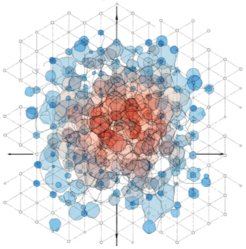A Breakthrough in Seeing Quantum Melting of Crystalline Electrons in Twisted Layers
Scientists uncover how electrons self-organize into crystalline patterns—and melt—inside atomically twisted 2D materials.

Scientists at the Max Planck Institute for the Structure and Dynamics of Matter, Nanjing University, Songshan Lake Materials Laboratory, and RWTH Aachen University have revealed an exciting new pathway to investigate "electron crystals" in twisted bilayer molybdenum diselenide (MoSe₂). They show how electrons can spontaneously arrange themselves into crystal-like patterns pinned to these moiré superlattices, expanding the ever growing catalog of tunable phenomena in moire materials (see also here). By stacking two atomically thin MoSe₂ layers at a slight twist angle, the researchers observed the formation of Generalized Wigner Crystals at a variety of fractional fillings, where strongly interacting electrons organize into repeating lattice-like structures. Crucially, these electrified crystals exhibit a "quantum melting" process, progressively dissolving into liquid-like states when key parameters—such as electron density, magnetic fields, and the relative alignment of the layers—are adjusted.
Angel Rubio, Director of the Theory Department at the MPSD, describes the breakthrough vividly: “It’s fascinating to see electrons forming a precise pattern, acting almost like a crystal in a solid.” Lei Wang, a professor of physics at Nanjing University and senior experimental author of the study, added, “By tuning different variables, such as magnetic and displacement fields, we observed how these electron crystals continuously melted, revealing the dynamic nature of quantum phase transitions.” Dante Kennes, professor at RWTH Aachen University also emphasized the broader significance: “Our work with twisted bilayer MoSe₂ may pave the way for more innovations in strongly correlated systems, helping us understand exotic phases of matter and their transformations.”
Beyond advancing the basic science of electron organization and phase transitions, these findings could inform the development of new quantum technologies. By pinpointing the conditions under which Generalized Wigner Crystals appear and dissolve, scientists can better harness and control the unusual properties of electrons in two-dimensional materials.
This study marks another milestone in the rapid development of twisted van der Waals materials and highlights their potential for revolutionary quantum technologies.












